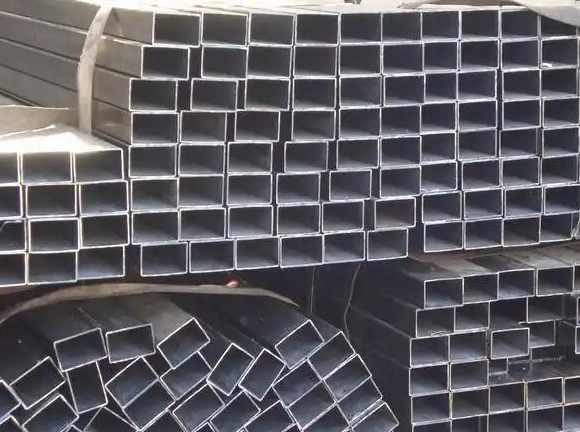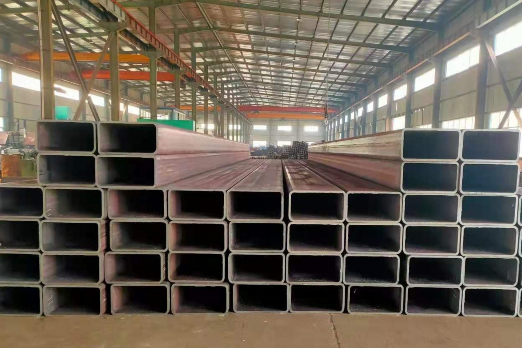What is ERW rectangular tube?
ERW rectangular tube is a rectangular steel tube manufactured using the high-frequency
electric resistance welding (ERW) process.
We can break it down from its name:
ERW refers to its production process—high-frequency electric resistance welding.
Rectangular tube refers to its rectangular cross-section. "Square rectangular tube" is often used as a general term, with "square tube" referring to a square cross-section and "rectangular tube" referring to a rectangular cross-section.

ERW Rectangular Tube Manufacturing Process:
The ERW rectangular tube manufacturing process is almost identical to that of
ERW square tube. The key steps include:
The coiled steel strip (steel plate) passes through a series of forming rollers, gradually bending the straight strip into a nearly circular tube blank. The skin effect and proximity effect generated by high-frequency current are then used to instantly heat the edges of the tube blank to a molten state. The tube is then pressure-welded and fused together using squeeze rollers.
A scraper is used to remove excess metal (burrs) squeezed from the inside and outside of the weld. After welding, the steel pipe enters a cooling section and passes through a sizing mill to ensure accurate diameter and roundness. Finally, it passes through a special set of dies and is gradually rolled into the desired rectangular or square cross-section. This process requires precise control to ensure angles and straight edges.
Key Features of ERW Rectangular Tubing:
1. Excellent Cross-Sectional Properties
A rectangular cross-section has different moments of inertia along its two principal axes, meaning it has varying bending resistance in different directions. This characteristic is very useful in structural design, allowing engineers to select the optimal installation method based on the direction of force, achieving efficient material utilization and saving steel.
2. High Strength and Good Bending and Torsional Resistance
As a closed tubular section, it has a significantly greater section modulus and bending and torsional stiffness than open sections such as angles and channels of the same weight, resulting in greater stability and improved load-bearing performance.
Shared Advantages with ERW Square Tubing:
High Efficiency and Low Cost: The ERW process offers continuous production, resulting in high efficiency and lower costs than seamless steel pipe.
High Weld Quality: High-frequency welds provide high strength and reliable performance.
High Dimensional Precision and Smooth Surface: Made from cold-rolled steel strip, it boasts precise dimensional control and a smoother, more attractive surface, free of scratches and other defects commonly found in seamless steel pipe.
Wide Specification Range: Available in a wide range of sizes and wall thicknesses.
ERW Rectangular Tube Specification Range:
1. Cross-sectional Size Range (H × B)
Rectangular tube dimensions are highly flexible, with aspect ratios (H/B) ranging from nearly 1 (almost square) to significantly larger.
Common Long Width (H) Range: 20 mm to 600 mm or even larger
Common Short Width (B) Range: 10 mm to 400 mm
Common Wall Thickness (t): 0.8 mm to 16.0 mm

Lengths: Typically 6 or 12 meters, but custom lengths are also available.
Surface Treatment: Black tube (untreated, with scale), galvanized (commonly used for rust prevention), painted, etc.
Common Length-to-Width Ratios (H/B): Typically up to 4:1 or 5:1. For example, a 400mm × 100mm rectangular tube is one of the most common extreme specifications. More extreme ratios (such as 500mm × 50mm) pose significant challenges in production and material strength and are therefore less common.
More detailed classifications:
Small rectangular tubes: H ≤ 80 mm. Commonly used in furniture, decoration, small brackets, etc.
Medium rectangular tubes: H between 80 mm and 200 mm. This is the most widely used range and is used in mechanical structures, building trusses, agricultural greenhouses, etc.
Large rectangular tubes: H > 200 mm. Primarily used in main beams and columns of large building structures, bridges, heavy machinery, etc.
Thin-wall tubes: t ≤ 3.0 mm. Mainly used in low-load applications such as decoration, furniture, and display racks.
Regular thick-wall tubes: t between 3.0 mm and 8.0 mm. This is the most popular range for structural applications, offering excellent strength and weight balance.
Thick-walled pipe: t > 8.0 mm. Used in critical structural areas subject to heavy loads and high pressures.
Common Standards:
ASTM A500: Primarily used in American standard projects, it is the most commonly used structural pipe standard in North America. It is divided into three grades: A500 Gr.A,
A500 Gr.B (most commonly used), and A500 Gr.C.
EN 10219: Suitable for European standard projects.
GB/T 6728-2017: Suitable for Chinese standard projects.
JIS G 3466: Suitable for Japanese standard projects.
Differences from seamless steel pipe:
Seamless steel pipe: Has no welds and is made by perforating round steel. Theoretically, it offers better pressure uniformity and is suitable for higher pressure applications, but also comes at a higher cost.
ERW welded pipe: Has a longitudinal weld seam. In most structural and low- to medium-pressure fluid transportation applications, its performance is fully sufficient to replace seamless steel pipe, offering an excellent price-performance ratio.
Applications of ERW Rectangular Tubing:
Due to its excellent performance and cost advantages, ERW rectangular tubing is widely used in the following areas.
1. Building Structures: This is the primary application area. It is used in columns, beams, and trusses in buildings such as factories, high-rise buildings, commercial complexes, stadiums, and bridges. When used as beams, rectangular tubing aligns the strong axis (the direction of greatest moment of inertia) with the primary load direction, making it very cost-effective.
2. Machinery Manufacturing and Equipment Frames: It is used in the manufacture of racks, brackets, bases, and guide rails for various mechanical equipment. Its flat surface facilitates the installation of other components.
3. Automotive and Rail Transit: It is used in chassis frames, body frames, and internal structural components for buses, trucks, and train carriages.
4. Containers and Logistics Warehousing: It is the primary material for container manufacturing and is also used in the poles and beams of heavy-duty racks and storage platforms.
5. Agricultural Greenhouses: It serves as the framework for greenhouses, offering high strength and corrosion resistance (typically requiring galvanizing).
6. Furniture Decoration: Used for creating modern-style tables, chairs, bed frames, partitions, display stands, and more, with a strong sense of design.
Conclusion:
ERW rectangular tube is a rectangular welded steel tube produced using high-frequency resistance welding technology. It perfectly combines the economic efficiency of the ERW process with the excellent structural performance of a rectangular cross-section, particularly in terms of bending resistance, maximizing material utilization. It is an indispensable key profile in modern architecture, mechanical manufacturing, and various engineering structures, and a symbol of efficiency, economy, and modernization.
Overall, ERW rectangular tubes come in a wide range of specifications, ranging from small decorative tubes to large structural tubes. The specific type you choose depends on your specific application scenario, load-bearing calculations (stress analysis), and budget.
Read more: ASTM A500 Rectangular Tube or Galvanized Square & Rectangular Tube



